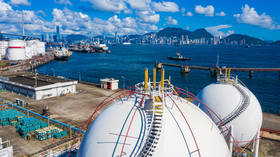EU set to import record volume of Russian LNG – data
Belgium, Spain, and France are among the top five buyers of the fuel, according to Global Witness
EU countries are set to buy record volumes of liquefied natural gas (LNG) from Russia this year, even as the bloc pledges to stop consuming Russian fuel by 2027, the latest findings published by Global Witness on Wednesday revealed.
Members of the bloc continued to import a significant amount of LNG from Russia in the first seven months of this year, data showed.
The EU has banned imports of Russian seaborne oil since the beginning of the conflict in Ukraine and drastically reduced shipments of pipeline gas from Moscow. LNG, however, has so far gone unsanctioned despite repeated calls from a number of EU officials.
Belgium and Spain were the second- and third-biggest buyers overall, purchasing 7.5 million cubic meters (mcm) and 7.1 mcm respectively, while France was fifth on the list with 4.5 mcm. China led the way with 8.7 mcm in LNG imports from Russia, while Japan was fourth with 7 mcm.
“It’s shocking that countries in the EU have worked so hard to wean themselves off piped Russian fossil gas only to replace it with the shipped equivalent,” said Jonathan Noronha-Gant, senior campaigner at Global Witness.
EU members bought 21.6 mcm of Russian LNG in total in the first seven months of this year, compared to 21.3 mcm during the same period in 2022. However, the figure represents a 40% surge compared to first seven months of 2021, which the report claimed was “embarrassing.”
The EU is estimated to have accounted for 52% of all Russian LNG exports between January and July, a market share that exceeds the 49% mark for 2022 and 39% for 2021.
The cost of LNG imported by members of the bloc in the first seven months of the year at spot market prices amounted to €5.29 billion ($5.77 billion), according to the report.
Analysts said the uptick in LNG purchases is even more significant given the fact that the EU did not import sizable amounts of the fuel from Russia prior to the conflict in Ukraine, instead relying on pipeline supplies.
Most shipments of Russian LNG come from the Yamal plant, a joint venture of the country’s largest LNG producer, Novatek, France’s TotalEnergies, China’s CNPC, and a Chinese state fund, the report said.
Recent data from Eurostat revealed a similar picture, showing that Russia was the EU’s second-largest supplier of LNG in the first quarter of 2023, behind the US but ahead of Qatar, Algeria, Norway, and Nigeria.
For more stories on economy & finance visit RT’s business section






Comments are closed.